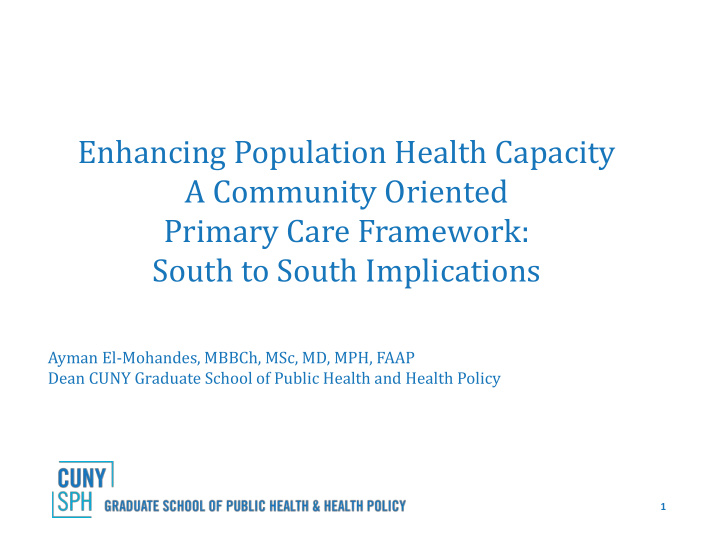



Enhancing Population Health Capacity A Community Oriented Primary Care Framework: South to South Implications Ayman El-Mohandes, MBBCh, MSc, MD, MPH, FAAP Dean CUNY Graduate School of Public Health and Health Policy 1
Definition In a 1999 publication, the American Public Health Association gave the following description of COPC: Community-Oriented Primary Care (COPC) is a systematic process for identifying and addressing the health problems of a defined population. It can be implemented with the resources available in most communities. Connors KM, author; Cashman S, Seifer SD, Unverzagt M, eds. 2003. Advancing the Healthy People 2010 Objectives Through Community-Based Education: A Curriculum Planning Guide. San Francisco, CA: Community- Partnerships for Health. To order the complete guide, visit www.ccph.info 2
The COPC Process 1. D efining and C haracterizing the community, 2. C onducting a C ommunity D iagnosis, 3. P rioritization of a Health Problem 4. D eveloping and I mplementing an intervention, and 5. M onitoring the I mpact of intervention…. An additional step added 6. Involving the community to carry out the preceding steps (Rhyne et al. 1998). 3
Community Involvement Is this different than community participation? Can it rise to the level of community ownership? Defining Community Capital Understanding and Promoting Supportive Cultural Trends Recruiting Opinion Leaders Developing a Culturally Informed Communication Strategy “Live and let live” Accepting errors in judgement and practice 4
When is the Right Entry Point? At the beginning, of course … Supporting a community in defining itself Disseminating data at the stage of community characterization Listening to the community’s priorities and identifying key entry points for an intervention Testing the cultural validity of an intervention strategy Transparency in evaluation VALUING COMMUNITY ++ PARTICIPATION AND REWARDING IT Sharing experiences and results from other communities 5
Underscoring Partnerships Common goals Synergy of purpose Cultural humility… the art of listening Vigilant avoidance of stereotyping (from both sides) Sharing of resources Community participation cannot always be… “in kind” Allowing the voiceless to speak Bringing in other community leaders with success stories 6
How Can Health Partnerships Enrich the Community Capital Improved health outcomes Enhanced community self reliance Increasing community self awareness Disseminating knowledge and skills Testing frameworks for sustainability 7
How Can Health Partnerships Enrich Health Systems Grounding policies and programs in life reality Infusing humility in the health care delivery system Increasing awareness of community capital Creating solid relationships of trust with community leaders Establishing a different level of accountability Establishing sustainability as a platform for intervention. 8
9
Recommend
More recommend